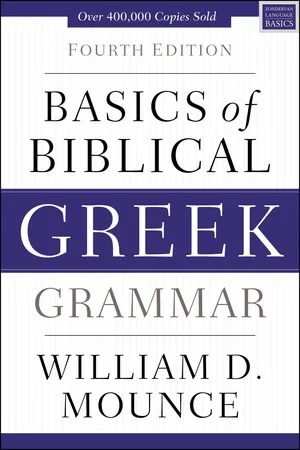
- 496 pages
- English
- ePUB (mobile friendly)
- Available on iOS & Android
About this book
Clear. Understandable. Carefully organized. Basics of Biblical Greek Grammar by William D. Mounce is the standard textbook for colleges and seminaries. Since its initial publication in 1993 its integrated approach has helped more than 250,000 students learn New Testament Greek.
The fourth edition of Basics of Biblical Greek Grammar has been updated throughout based on continuing feedback from professors, students, self-learners, and homeschoolers, making it even more effective for today's students. Other improvements have been made based on recent developments in scholarship.
The key to the effectiveness of Basics of Biblical Greek Grammar in helping students learn is in how it introduces them to the language. Students learn about the features of the Greek language in a logical order, with each lesson building upon the one before it. Unnecessary obstacles that discourage students and hinder progress are removed, such as rote memorization of endless verbal paradigms. Instead, students receive encouragement along the way to assure them they are making the necessary progress. Detailed discussions are also included at key junctures to help students grasp important concepts.
By the time students have worked their way through Basics of Biblical Greek Grammar they will have learned:
- The Greek Alphabet
- Vocabulary for words occurring 50 times or more in the Greek New Testament
- The Greek noun system
- The Greek verbal system, including indicative and nonindicative verbs, and participles
A robust suite of learning aids is available for purchase to be used alongside the textbook to help students excel in their studies. These include a workbook, video lectures for each chapter featuring the author, flashcards keyed to vocabulary in each chapter, a laminated quick study sheet with key concepts, and audio of the vocabulary for each chapter to aid in acquisition.
Frequently asked questions
- Essential is ideal for learners and professionals who enjoy exploring a wide range of subjects. Access the Essential Library with 800,000+ trusted titles and best-sellers across business, personal growth, and the humanities. Includes unlimited reading time and Standard Read Aloud voice.
- Complete: Perfect for advanced learners and researchers needing full, unrestricted access. Unlock 1.4M+ books across hundreds of subjects, including academic and specialized titles. The Complete Plan also includes advanced features like Premium Read Aloud and Research Assistant.
Please note we cannot support devices running on iOS 13 and Android 7 or earlier. Learn more about using the app.
Information
Section Overview 1
Chapters 1–4
Chapter 1
Chapter 2
Chapter 3
Chapter 4
Chapter 1
The Greek Language
Table of contents
- Cover Page
- Title Page
- Copyright Page
- Dedication
- Table of Contents
- Preface
- Abbreviations
- Rationale Statement
- BillMounce.com
- FlashWorks
- Part I: Introduction
- Part II: Noun System
- Part III: Indicative Verb System
- Part IV: Participles
- Part V: Nonindicative Moods and μι Verbs
- Appendix
- Vocabulary Words By Frequency
- Lexicon
- Index